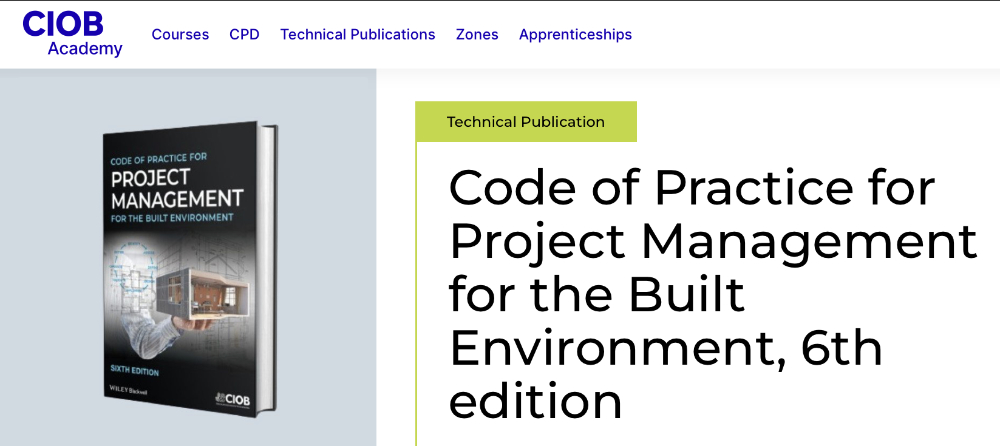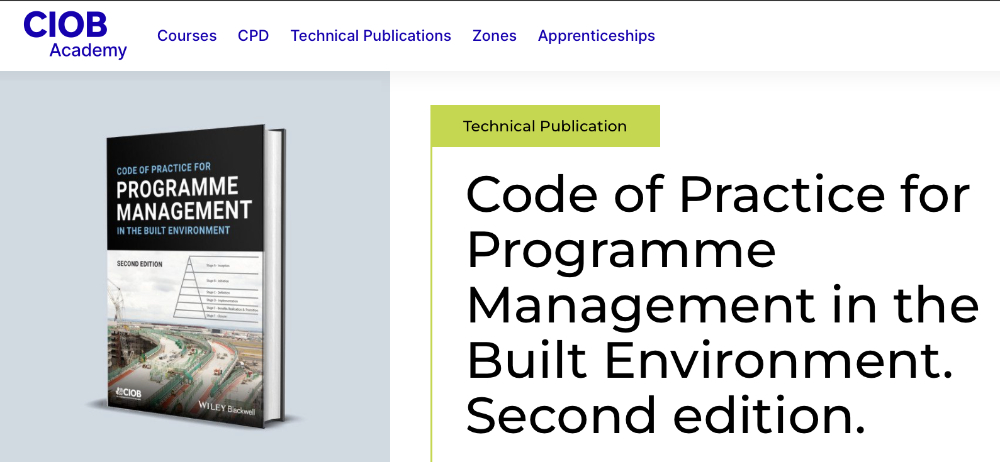Built environment project and programme management codes of practice
A project is a series of related a tasks which when they are carried in the correct order will lead to the completion of the project. Projects will tend to run independently of the businesses involved in them and follow their own schedule. A programme is a series of interrelated projects that may be carried out repeatedly or continuously in order to support an ongoing process.they tend to be integral to the businesses carrying them.
[edit] The Code of Practice for Project Management for the Built Environment
The latest (sixth) edition of construction project management processes, set within the context of a number of key drivers in the industry, including the need for smart and sustainable solutions and increased value, innovation, safety and informationsharing.
The Code of Practice for Project Management for the Built Environment delivers an up-to-date and comprehensive reference to the principles and practice of project management in construction and development. This latest (6th) edition covers the new technologies, internationalisation, changing legislation, and productivity and profitability challenges faced by contractorsthat are driving significant change in the industry.
A thorough walk through of project inception, feasibility analysis, strategy, and the pre-construction process. Plus comprehensive explorations of the construction stage of projects, as well as testing and commissioning, and projectcompletion, handover, and operation.
This article appears on the CIOB Academy website as 'Code of Practice for Project Management for the Built Environment, 6th edition'.
[edit] Code of Practice for Programme Management in the Built Environment. Second edition
This second edition of the Code of Practice for Programme Management in the Built Environment is a natural developmentfrom the first edition and builds on the recently published 6th edition of the highly successful Code of Practice for Project Management for the Built Environment.
The sixth edition for Project Management continues to provide the relevant guidance and procedural requirements for the successful management of individual projects. This second edition of Programme Management further develops the elements of functionality and procedures specific to the management and successful delivery of a number of related projectswithin the built environment, focussed at the programme level on the coordinated creation of value, which presents itself as a trade-off in the relationship between:
- Benefits and outcomes (via outputs);
- Risks and opportunities;
- Requirements and objectives (incl. cost and time).
- Authored and supported by industry and government experts in the field.
This article appears on the CIOB Academy website as 'Code of Practice for Programme Management in the Built Environment. Second edition'.
--CIOB
[edit] Related articles on Designing Buildings
- CIOB articles,
- Code of Practice for Programme Management in the Built Environment. Second edition.
- Code of Practice for Project Management for the Built Environment, 6th edition.
- Design management.
- Portfolio v programme.
- Preliminary business case.
- Project execution plan.
- Project management.
- Risk management.
- Value management.
Featured articles and news
Homes England creates largest housing-led site in the North
Successful, 34 hectare land acquisition with the residential allocation now completed.
Scottish apprenticeship training proposals
General support although better accountability and transparency is sought.
The history of building regulations
A story of belated action in response to crisis.
Moisture, fire safety and emerging trends in living walls
How wet is your wall?
Current policy explained and newly published consultation by the UK and Welsh Governments.
British architecture 1919–39. Book review.
Conservation of listed prefabs in Moseley.
Energy industry calls for urgent reform.
Heritage staff wellbeing at work survey.
A five minute introduction.
50th Golden anniversary ECA Edmundson apprentice award
Showcasing the very best electrotechnical and engineering services for half a century.
Welsh government consults on HRBs and reg changes
Seeking feedback on a new regulatory regime and a broad range of issues.
CIOB Client Guide (2nd edition) March 2025
Free download covering statutory dutyholder roles under the Building Safety Act and much more.
Minister quizzed, as responsibility transfers to MHCLG and BSR publishes new building control guidance.
UK environmental regulations reform 2025
Amid wider new approaches to ensure regulators and regulation support growth.
BSRIA Statutory Compliance Inspection Checklist
BG80/2025 now significantly updated to include requirements related to important changes in legislation.


























